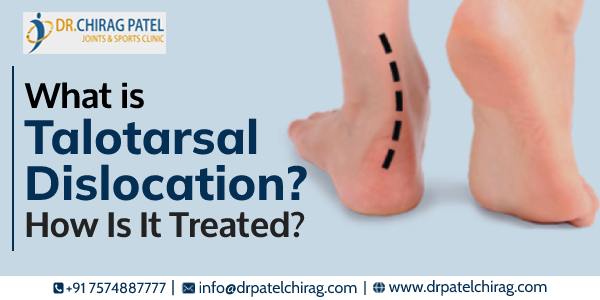Though it sound’s complicated, Talotarsal Dislocation in simple terms is an ankle dislocation that happens when ankle bone displaces from its usual position. Talotarsal Dislocation is one of the most common ankle conditions that is suffered by millions of people around the world. And yet, unfortunately, it is also the most misdiagnosed and under-treated condition which makes the symptoms linger causing a variety of problems in the longer run.
So it is very important to have first-hand information about this under-treated condition. And hence with inputs from Best Orthopaedic and foot surgeon in Mumbai, Dr Chirag Patel we aim to provide the right information about Talotarsal Dislocation in this blog here. Read on:
Anatomy of Ankle Joint:
The ankle bone we often see is comprised of four bones – tibia, fibula, talus and calcaneus. While calcaneus forms the base (heel), the tibia and fibula form a notch into which the talus fits in to form an ankle joint. In addition to working as a shock absorber during heel strikes, this ankle joint is responsible for all the movements of the foot. This talus is again attached to the tarsals that connect to finger bones (for simplicity) forming an entire foot.
What is Talotarsal Dislocation?
Talotarsal dislocation as the name sounds is the abnormal displacement of the talus of the ankle joint and tarsal from their usual position. In simple terms, anklebones (talus and tarsals) are displaced from their normal position which results in inward rotation of ankle bone and outer rotation of outside of the foot.
Given the talus and tarsal is the nearest to the ground, it forms a crucial foundation and also any abnormal impact on this bones or joint while have a ripple effect on other joints inline (hip & knee). This is why Talotarsal dislocation must be promptly treated by an orthopaedic and foot surgeon to reduce the impact on other joints.
Symptom of Talotarsal Dislocation:
Talotarsal dislocation can cause excessive strain and pressure on our bone and ligaments which they are exactly designed to endure, As a result, this abnormal strain results in secondary musculoskeletal conditions resulting in the following symptoms over time:
- Bunions
- Spurs on heels
- Knee, hip, heel or back pain.
- Neck, back or shoulder pain.
- Tendon and ligament problems.
Also, both Talotarsal dislocation and the symptoms do not go away on their own and need assistance from an expert orthopaedic surgeon and foot specialist in Mumbai.
Treatment for Talotarsal Dislocation in Mumbai:
As the Talotarsal dislocation presents itself in variety of symptoms, in most cases orthopaedic experts do not find the right cause of these symptoms. The first step toward the Talotarsal dislocation treatment is correctly assessing the severity and cause of the condition. Based on this information an orthopaedic and foot specialist will be treating the condition with physio-therapy surgery or less invasive internal stabilization procedures. If you are in Mumbai and are looking for Talotarsal dislocation treatment in Mumbai, you can find orthopaedic surgeon and foot specialist Dr. Chirag Patel here





